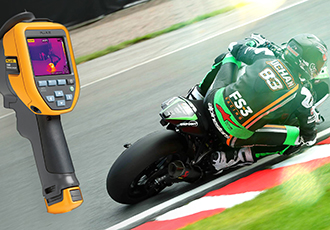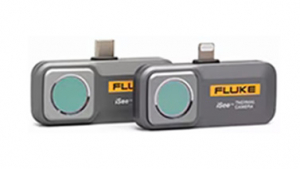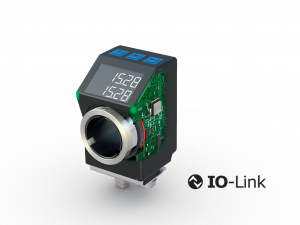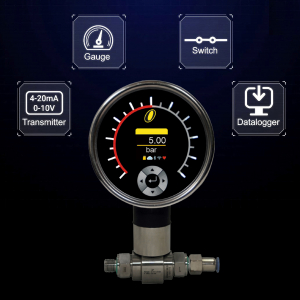Thermal imaging technology gives FS-3 Racing a competitive edge

Anyone familiar with motor racing will appreciate how crucial tyres are. The phrase ‘where the rubber meets the road’ is often used as a metaphor, but taken it reflects the fact that, no matter how big or powerful your mode of transport, the only way of turning all that performance into actual motion is through an area of rubber about the size of your palm.
By Jonathan Albrow, Technical Content and Data Manager at Microlease
With two-wheeled vehicles you have two palm-sized points of contact. Only one of these is transferring power, the other is simply there to keep you on the right track, but it is vital that both operate at their peak performance.
With speeds in excess of 180mph and the ability to generate 220bhp, the British Superbikes class of motorsport is the perfect example of how tyre and track temperatures can affect the outcome of a race. The tyres typically come in two compounds, soft and hard. In dry conditions teams use slick tyres, without the grooves used to disperse water.
Maintaining the optimal tyre temperature for the weather and track conditions, including track temperature, depends on the experience and skill of the pit crew and the rider. Understanding how the tyre temperature changes during a race can give teams an advantage, which, even if slight, could secure a higher finishing place or even a coveted spot on the podium.
The FS-3 Racing team recently had the opportunity to put some of the latest technology to the test during a round of the British Superbike Championship, held at Brands Hatch. According to Nigel Snook, FS-3 Racing Team Principal, the insights they gained were enlightening.
Snook said: “A tyre at the correct temperature grips better and lasts longer. If it is too cold or too hot then the result is either a lack of performance at best, or a high-speed crash at worst. Getting it right depends on knowing with accuracy the temperature of both the tyre and the track surface.”
Of course, temperature sensing is nothing new, but thermal measurement using conventional sensors needs physical contact between the material and the sensor. Such systems are ideal for laboratory conditions, but in the pit lane they are cumbersome and often slow to react. Heat from the material being measured has to be transferred through conduction to the sensing element, which takes time.
The use of thermally sensitive imaging sensors that harness energy in the infrared part of the spectrum provides a much more responsive solution, and one that can be carried out without physical contact. Access to the Fluke family of hand-held, battery-powered thermal imaging cameras, which includes the FLK-TI400-60HZ, provided the FS-3 team with the chance to put this to the test, while also gaining vital information about the state of their tyres and the track.
The Pirelli soft and hard compound slick tyres used by British Superbikes cater for two general conditions. The SC0 compound is used when the track’s temperature is above 20°C, and the harder SC1 is used in cooler conditions. However, there will be some crossover in conditions. If an SC0 compound is used at cooler temperatures the tyre will rapidly become inefficient, while using an SC1 compound in warmer conditions will also result in a loss of grip. The temperature of the tyre before it goes onto the bike is also crucial, which is why all tyres are treated to their very own warming blanket to raise and maintain the temperature.
Reaching that temperature happens over a period of around two hours before the race, and the tyres are kept at a temperature of 90°C throughout the race. They are only uncovered moments before they are put onto the bike.
“Using the Fluke thermal imaging camera was a revelation for the team,” continued Snook. “When aimed at the tyre warming rack, it showed up any cold spots in the blankets. It was so accurate that we could even see the heat being given off by the individual cables, as well as the true temperature of the tyres.” This information meant the team were able to rotate and reposition the tyres on the rack to maintain tyre temperature and select the best tyre for the conditions.
Furthermore, using the Fluke thermal imaging camera to read the temperature of the bike and its tyres after practice sessions clearly showed the rate at which the tyres lost their heat, due to the speed at which the bike was travelling and the ambient conditions.
Snook explained: “We could see that the tyres were going out on to the track at 90°C but they had dropped to just 45°C after practice. This information was useful to relay back to the rider, who could then work harder at keeping his speed up in order to retain heat in the tyres.
“We also know that the track temperature is influential in the tyre choice, specifically when it is around that ‘magic number’ of 20°C. Using this amazing imaging camera we were able to measure the track’s surface temperature from a distance; in fact we could measure the actual track temperature rather than the temperature in the pit lane. This gave us a much better idea of when to move from a soft to hard compound.”
The influence of high temperatures isn’t limited to tyres. Other elements, such as brake disks and callipers, the rear suspension unit, and the oil and water radiators, are all sensitive to extreme temperatures. While there isn’t the same level of empirical data to show how the performance of these elements is affected, the FS-3 team found it hugely interesting to use the thermal camera to examine them.
This enabled them to start building a picture of how managing the temperature might offer racing advantages. “The mechanics were particularly interested in using this technology to help them position sensitive electronic components that need to be kept away from extreme heat sources,” added Snook.
Could your engineers benefit from access to this kind of advanced temperature sensing equipment? Through Microlease and its exclusive partnership with Fluke, they can. Microlease offers a range of options for buying, leasing or renting the Fluke family of thermal imaging cameras, as well as a huge range of other test equipment that could give your company that competitive edge.
To enter Microlease’s competition for the chance to win two tickets to the British Superbike Championship enter here.
For more information about the Fluke family, click here.
Similar articles
More from Microlease Ltd
- Thermal imaging technology gives FS-3 Racing a competitive edge 12th April 2019
- Energy meters in the van as Microlease eyes industrial market 9th April 2019
- Microlease takes on VAR role for Fluke 3rd September 2018
- Asset-based management solution slashes costs 17th September 2017












Write a comment
No comments